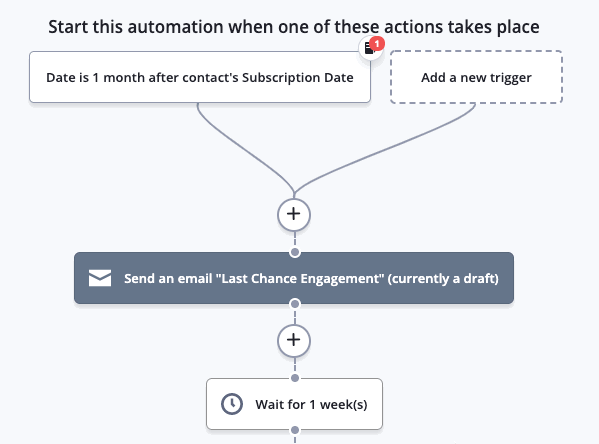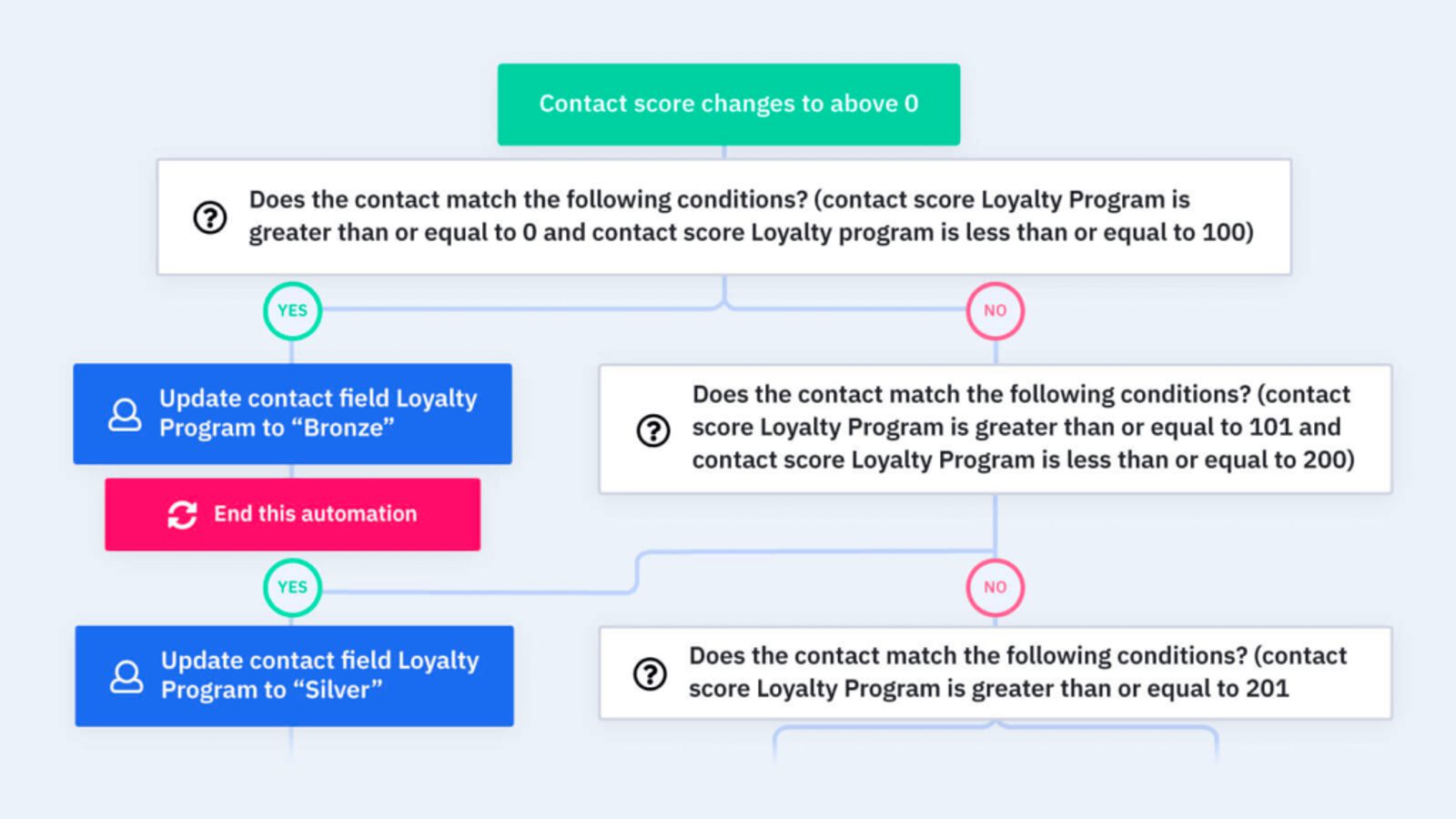Building and maintaining connections is paramount in the vast business world. This is especially true for marketers and solopreneurs. But what happens when those connections—your customers—begin to fade away?
Enter "win-back strategies." These strategies are designed to rekindle relationships with customers who've drifted apart from your brand. Think of it like catching up with an old friend after years of silence, making the bond even stronger.
While the idea might sound straightforward, implementing it effectively requires a mix of tact, insight, and the right tools.
As we delve into win-back strategies, we’ll discover key insights into reconnecting with customers. This journey emphasizes the importance of tools like ActiveCampaign, which focuses on understanding customers and boosting engagement.
These tools aren't just about sales—they're allies in reviving relationships. Their features enhance communication, making the process of reconnecting smoother. While exploring win-back strategies, we see how this approach is crucial for successful reconnection.
Understanding win-back strategies
The ebb and flow of customers is a natural part of business. But what if you could turn that tide, bringing back those who've moved on? Win-back strategies provide a roadmap to do just that. Before implementing them, however, it's essential to understand their nuances and the advantages they offer.
What are win-back strategies?
At their core, win-back strategies are tailored efforts designed to re-engage customers who have become inactive or disengaged. Picture a scenario where a once-loyal customer hasn't interacted with your brand in months. Instead of considering them a lost cause, you reach out with a specially crafted message or offer, reigniting their interest.
For email marketers, these strategies are indispensable. The digital realm is vast, with countless brands vying for attention. Amidst this competition, it's common for customers to stray, lured by a new offer, or simply due to inactivity. However, since these individuals were once interested in your brand, reigniting that spark is often easier than kindling a new one. That’s where Win-back strategies come in. They offer the methodology and tools needed to do this effectively.
Benefits of win-back strategies
While there are numerous advantages to implementing win-back strategies, a few stand out more prominently than others, enhancing your marketing endeavors and deeply impacting your brand's bottom line and customer relationship. Let's delve into three of the most significant benefits these strategies offer:
- Increased customer retention strategies: A primary advantage of win-back strategies is their boost to customer retention rates. Engaging existing customers and reminding them of your brand's value can rekindle their loyalty. And, as many businesses have come to realize, retaining a customer is far more valuable (and cost-effective) than acquiring a new one.
- Cost-effectiveness: Speaking of cost, let's break it down. Acquiring first-time customers involves marketing campaigns, advertising costs, and potentially even discount offers to entice them. In contrast, a win-back strategy leans on the foundation of an already established relationship. The cost of sending a personalized email or a tailored offer is significantly less, making it a more economical approach in the long run.
- Strengthened brand loyalty: Beyond the numbers, win-back strategies offer something more intangible yet invaluable—strengthened brand loyalty. When customers realize a brand values them enough to reach out and reignite the relationship, it fosters customer trust and loyalty. Using tools like ActiveCampaign, brands can craft genuine, heartfelt messages that resonate with customers, reinforcing the bond.
Recognizing the need for win-back efforts
Before diving into the strategies to win back customers, it's imperative to recognize when and why such efforts are necessary. Just like how a doctor diagnoses a condition before prescribing a treatment, marketers should identify and define the signs of waning customer engagement.
In this section, we'll delve into the various signs that indicate a need for your win-back campaigns and how tools like ActiveCampaign can guide your diagnosis and subsequent actions.
Identifying Your At-Risk Customers
It's not always glaringly obvious when a customer disengages from your brand. Subtle shifts in their behavior, decreased interaction with emails, or a sudden pause in regular purchases are some early warning signs. It's essential for marketers to:
- Monitor engagement rates: Regularly check metrics like email open rates, click-through rates, and website interactions.
- Keep an eye on purchase frequency: A decrease might suggest they're finding value elsewhere.
- Notice feedback and reviews: A once vocal advocate going quiet? It might be a red flag.
Platforms like ActiveCampaign allow marketers to easily track these metrics and get insights on customer engagement trends.
Analyzing purchase history
Purchase patterns offer a treasure trove of insights into customer behavior. Regular purchase intervals, preferred products, and seasonal buying trends can provide cues about their preferences and pain points. Whatever tool you use to track your purchase history should provide you with the details you need to get started. For example, ActiveCampaign's robust analytics:
- Provide detailed insights: Understand the products a customer gravitates towards and those they avoid.
- Track buying frequency: Spot any deviations from their usual buying pattern.
- Offer predictive analytics: Forecast potential buying behavior based on historical data.
This type of in-depth analysis allows your business to craft personalized offers or content, improving re-engagement chances.
Identifying inactive customers

The term 'inactive' is relative and varies between businesses. For some, a customer who hasn't made a purchase in three months might be deemed inactive, while for others, it might be six months or longer. It's crucial to:
- Define inactivity for your business: Understand the typical engagement cycle and set a benchmark. Consider not just your customer purchase history, but also your industry.
- Use tools to track: Segmentation tools can help you identify customers who haven't engaged within the defined period, making them prime targets for win-back campaigns.
Assessing unhappy customer reports
Feedback, both positive and negative, is gold for businesses. Unhappy customer reports shed light on areas of improvement, but more than that, they offer an opportunity to mend a relationship. Here's how:
- Actively seek feedback: Encourage customers to share their experiences, be it through reviews, surveys, or direct communication.
- Analyze feedback trends: Use tools like ActiveCampaign to collate feedback and spot recurring issues or concerns.
- Engage and address: Reach out to customers, acknowledge their concerns, and show genuine efforts in resolving them. This act can transform a disgruntled customer into a brand advocate.
Remember, every piece of feedback is a chance to better your service and build stronger bonds with your audience.
Planning the re-engagement drive
Embarking on a re-engagement journey is more than just a series of emails or offers. It’s a well-thought-out marketing strategy that takes into consideration the reasons for customer disengagement and crafts tailored solutions. This section will guide you through the steps of developing a winning re-engagement plan, ensuring positive customer experiences, and upping your customer service game.
Developing a plan to re-engage customers
Re-engagement isn’t a one-size-fits-all formula. It necessitates understanding individual customer needs and preferences. Here’s how to go about it:
- Define your goals: Before anything, establish a clear objective. Is your aim to boost sales, increase the click-through rates on emails, or perhaps regain lost subscribers? It could be a combination of these. By identifying your goals upfront, you can create tailored strategies to achieve them.
- Segment your audience: Understand that not all inactive customers have the same reasons for their inactivity. Using platforms like ActiveCampaign allows you to segment your audience based on various metrics: behavior, purchase history, engagement levels, and more. This segmentation is crucial as it lets you address each group with a unique approach.
- Craft-tailored messaging: A simple, generic "We Miss You" might not resonate with everyone. Instead, create messages that genuinely address their specific reasons for inactivity. Was it a product issue? A service problem? Or perhaps they found a better price elsewhere? Addressing their concerns head-on can reignite their interest.
- Choose the right channels: It's about what you say and where you say it. Determine where your audience is most active: email, SMS, social media, or somewhere else. Some segments might prefer one channel over another, so tailor your efforts accordingly.
- Monitor and iterate: Once your re-engagement strategies are in motion, don't just set and forget. Constantly track the effectiveness of your campaigns. Most platforms offer analytical tools to assess campaign success, allowing you to tweak and perfect your strategies over time.
Creating positive experiences for current and potential customers
In the age of digital marketing, positive experiences act as a bridge between brands and customers. These experiences determine whether a customer chooses to stay or seek alternatives.
- Understand their journey: Begin by mapping the entire customer journey, from initial contact to post-purchase interactions. Recognize any potential pain points or hindrances. This understanding will guide your efforts to smooth out their journey and ensure a seamless experience.
- Engage regularly: Regular engagement is key to keeping your brand top-of-mind. Make sure you are using a platform that facilitates the sending of tailored content, special offers, and timely updates, ensuring customers always feel valued and not just another statistic.
- Seek feedback and act: Proactively asking for feedback is vital. But what's more important is showing that you're acting on it. Making changes based on customer feedback addresses immediate concerns and signals to customers that their voice genuinely matters, fostering trust.
You can boost loyalty and prevent potential disengagement by ensuring positive interactions at every touchpoint.
Improving customer service performance standards
High-quality customer service can be the difference between a one-time customer and a lifelong advocate. Elevating your support standards ensures that customers feel heard and valued.
- Set clear standards: Begin by outlining precise performance metrics for your contact center team. Whether it is response time, resolution rate, or overall customer satisfaction score, clear metrics ensure a benchmark to meet and exceed..
- Train and equip your team: Equip your team not just with tools but also with comprehensive training. They should be adept at using your CRM platform to their fullest, ensuring each customer interaction is informed and personalized.
- Automate and track feedback: Post-interaction feedback is invaluable. With ActiveCampaign's feedback tools, you can gauge real-time customer sentiments, understanding what went right and where there's room for improvement. Regularly sifting through this feedback ensures that your team remains aligned with customer expectations and continuously evolves.
Excellent customer service, coupled with the analytical prowess of ActiveCampaign, ensure a brand experience that customers cherish and advocate for.
Building and sustaining loyalty

I’ve said this once, but it’s worth saying again. Retaining a current customer is far more cost-effective than acquiring a new one. Loyalty isn't just a metric; it's the pulse of your brand's relationship with its audience. But how can you foster and fortify this bond? Beyond superior products and excellent service, there are targeted strategies that you can employ, many of which become more efficient and effective with the integration of tools like ActiveCampaign.
Setting up a loyalty program or rewards system
At its core, a customer loyalty program is a structured strategy to reward customers for frequent interactions and purchases. These rewards can range from discounts or points redeemable for products to exclusive deals and more.
The benefits of loyalty programs are many:
- Improved retention: Customers are less likely to jump ship when rewarded for their repeat business. They value the appreciation shown towards their loyalty.
- Increased sales: Offering exclusive deals or points that are redeemable urges customers to purchase more, boosting revenue.
- Valuable data collection: Loyalty programs, especially when digital, can provide invaluable insights into purchasing habits and preferences.
Setting up a loyalty program doesn’t have to be complicated. Using automation, you can segment your audience based on purchasing behavior, ensuring that rewards resonate with individual preferences. Automated email campaigns can update customers about their points, exclusive deals tailored for them, and even remind them if they're close to a new reward, maintaining engagement and excitement.
Offering discounts and promotions
Discounts and promotions are age-old tactics in the marketing playbook. However, it's a tightrope walk between attracting customers and maintaining profitability.
Striking the right balance demands that promotions are timely, targeted, and relevant. A seasonal discount, for instance, might see high uptake but isn't as personalized as a birthday discount or an anniversary sale. The key is to understand your customer lifecycle and offer discounts that attract and make them feel valued.
A solid platform amplifies the power of promotions. For example, ActiveCampaign’s segmenting abilities help you craft deals for specific audience clusters, such as sending a high-value customer a more significant discount as a token of appreciation. Meanwhile, email automation ensures that the promotions reach the customer at the right time, increasing the likelihood of conversion.
Using social proof to showcase success
In today's digital age, word-of-mouth has metamorphosed into reviews and testimonials. Social proof, which includes customer reviews, testimonials, and endorsements, can significantly sway purchasing decisions.
The power of social proof lies in its authenticity. When potential customers see others praising a product or service, it alleviates their apprehensions, reinforcing their decision to purchase. Positive reviews can bolster a brand's credibility, while constructive feedback allows businesses to showcase their customer-centric approach by addressing and rectifying issues.
Getting this feedback relies on the platform you use. Automated email campaigns can solicit reviews from customers post-purchase while segmentation ensures that these requests are timely—for instance, asking for a review too soon might be ineffective while delaying might lead to the customer forgetting key details.
Once gathered, these reviews can be showcased in subsequent campaigns, weaving a narrative of trust and excellence.
Executing the win-back strategy
Crafting a strategy is one part of the puzzle; execution is where the rubber meets the road. Properly implementing your win-back tactics ensures that all the effort spent in planning doesn't go in vain. ActiveCampaign can be an indispensable ally in this phase, offering a suite of features tailored for businesses aiming to reconnect with disengaged customers.
Launching win-back campaigns
Initiating a win-back campaign requires more finesse than a regular promotional drive. The objective here isn't just to inform but to remind, rekindle, and renew. Here's how you can make your win-back campaign effective:
- Identify your audience
- Segmentation is key: Before you even begin drafting your message, you need to know who you're addressing. Delineate your customer base into segments such as long-term inactives, recent drop-offs, or one-time buyers.
- Actionable tip: Use ActiveCampaign's detailed audience segmentation tools. For instance, filter out customers who haven’t made a purchase in the last six months. This list is your primary target for the win-back campaign.
Crafting personalized messages
In the vast expanse of digital communication, personalization can be the beacon that draws customers in. People yearn for a human touch, even in automated emails. This is where segmentation plays a pivotal role.
Segmentation helps you tailor messages that resonate with your audience. For instance, a customer who previously bought winter wear might be interested in a discount on boots.
ActiveCampaign shines in this realm. Its robust segmentation tools allow you to craft distinct, resonant messages for each segment. The platform's dynamic content feature ensures that every recipient gets content that appeals specifically to them, amplifying the chances of re-engagement.
Use email marketing automation tools
Automation in email marketing is often thought of as a tool for mass communication. But its real power lies in its ability to deliver precision at scale.
Win-back efforts demand that you are always on your toes, sending the right message at the right time. Doing this manually can be a herculean task. Marketing automation tools simplify this. From automating segmentation to sending timely follow-ups, automation ensures that you’re always in sync with your audience's pulse.
While the thought and strategy fuel win-back efforts, execution is where you’ll see results.
Conclusion
In the ever-competitive world of digital marketing, retaining existing customers isn't just a strategy; it's a necessity. Win-back strategies act as a bridge, reconnecting you with your customers who may have drifted away, ensuring that these valuable customer relationships aren't lost in the vastness of the digital ocean.
It’s not merely about reigniting lost sales but about reaffirming your brand's value, rekindling trust, and renewing engagements.
The process might seem daunting, but with tools like ActiveCampaign, it becomes not just manageable but also highly efficient. By leveraging the robust features of ActiveCampaign, from audience segmentation to predictive sending, you can craft re-engagement campaigns that resonate, captivate, and convert.
Remember, in business, it's often not the first impression but the renewed connection that leaves a lasting mark. So, as you contemplate strategies to grow and prosper, consider the goldmine that is your past customer base and employ ActiveCampaign to ensure your win-back endeavors are both strategic and successful.









